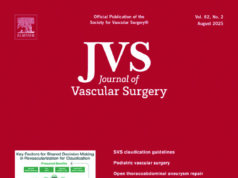
A recent study examining the effect of operative approach on outcomes in patients presenting with ruptured abdominal aortic aneurysm (rAAA) demonstrated clear short- and midterm survival benefits of endovascular repair over an open approach.
The authors—Linda J Wang, MD, of Massachusetts General Hospital in Boston, and colleagues—add that these benefits persisted after matching on all major demographic, comorbid and anatomic variables. In addition, patients undergoing open repair used more hospital resources, with longer length of stay, higher estimated blood loss, longer procedure times, and higher complication rates.
Wang et al, writing in the August issue of the Journal of Vascular Surgery (JVS), suggest a more aggressive endovascular approach for rAAA in patients with suitable anatomy.
The authors note that even with repair, rAAA has a mortality rate ranging from 20–50%. While EVAR has provided an “attractive, less invasive alternative to open surgical repair,” with the potential to reduce the high mortality associated with rAAA intervention, the literature remains “mixed” on whether EVAR provides a survival benefit over open repair for rAAA.
Wang et al argue that the three randomized controlled trials (RCTs) that examined the effects of operative strategy on rAAA outcomes were “poorly designed and heavily criticized,” and therefore “limited in their real-world applicability”. As a result of this, the investigators sought to compare the two treatment modalities using a propensity-matched analysis in a ‘real-world’ setting.
They cite “high crossover rates, small sample sizes, and restrictive exclusion criteria” could, in part, explain why Wang et al’s results differ from these large trials.
Of note, however, the largest of the three RCTs in question—the IMPROVE (Immediate management of patients with rupture: open versus endovascular repair) trial, which enrolled 613 patients across 30 centers—did in fact reveal a survival advantage and reduced costs compared with open repair at three years, in keeping with the findings of the present study.
Wang and colleagues analyzed all ruptured cases of open surgical repair and endovascular aneurysm repair (EVAR) in the Vascular Quality Initiative (VQI) performed between 2003 and 2018. They compared raw and propensity-matched EVAR and open surgical repair cohorts.
Primary and secondary outcomes included postoperative major adverse events (cardiovascular, pulmonary, renal, bowel or limb ischemia, reoperation) and 30-day and one-year mortality. Wang et al performed univariate, multivariate, and Kaplan-Meier analyses.
The investigators detail that there were 4,929 rAAA repairs performed—2,749 EVAR and 2,180 open repair. They report that, compared with EVAR patients, open repair patients had higher rates of myocardial ischemic events (15% vs. 10%; p<0.001), major adverse events (67% vs. 37%; p<0.001), and 30-day death (34% vs. 21%; p<0.001).
On adjusted analysis, open repair was predictive of 30-day mortality (odds ratio 1.8, 95% confidence interval [CI] 1.5–2.2). After 1:1 matching, the study cohort consisted of 724 pairs of open and EVAR cases. The open repair patients had twice the length of stay (median 10 days [interquartile range 5–19 days] vs. five days [interquartile range 3–10 days]; p<0.001).
Furthermore, univariate analysis demonstrated persistent increased 30-day mortality after open repair (32% vs. 18%; p<0.001) and higher rates of myocardial infarction (14% open vs. 8% EVAR; p=0.002), respiratory complications (38% vs. 20%; p<0.001), and acute kidney injury (42% vs. 26%; p<0.001). The overall major adverse event rate was higher after open repair (68% vs. 35%; p<0.001).
Multivariate regression analysis of the propensity-score matched pairs demonstrated that open repair was associated with double the 30-day mortality compared with EVAR (odds ratio 2; 95% CI 1.6–2.7).
Finally, Wang et al state that all-cause one-year survival was 73% and 59% after EVAR and open repair in the propensity-matched cohort, respectively (p<0.001).
The authors acknowledge several limitations to this study, including the fact that this is a retrospective review of a prospectively maintained database, which is prone to missing data and entry errors.
Other limitations they cite include the limitations of the VQI in its ability to provide some aneurysm-specific anatomic details, a potential selection bias due to the fact that the VQI captures only a percentage of AAA repairs performed in the U.S., and the fact that there may remain unidentified differences between the groups not accounted for in this analysis.












